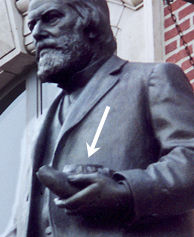
August 9, 2006

The fossil jaw of Panthera atrox can be seen in the left hand of the Joseph Leidy statue that stands in front of The Academy of Natural Sciences of Philadelphia in Pennsylvania.
All this month, the newspaper of Richmond, Indiana, the Palladium-Item has been re-posting archival articles from 60 years ago about the sightings of “Varmints” there. Contemporary readers seem to have at first thought the reporters back then were talking about Bigfoot, but, of course, it was mystery cats that were being remembered. It is these same Varmints that cryptozoologists such as myself and Minnesota researcher Mark A. Hall had written about thirty years ago. In fact, I first detailed the Varmints in the pages of Creatures of the Outer Edge in 1978.
These accounts capture the essence of the theory that Hall and I have promoted, namely that Panthera atrox, the Pleistocene American lion – a giant cat found in the La Brea Tar Pits and at other fossil sites – may have survived into modern times. The Toney and Turner boys sightings give a good example of the giant melanistic and brown felid cryptids that still walk among us. “Black panthers,” greatly accepted in America, have not been scientifically confirmed.
The following are edited extracts of how I have noted these example cases in the midst of a 60 page-section on mystery cats in Mysterious America (which comes back into print in the spring of 2007) and Creatures of the Outer Edge .
In 1948, thanks to the tedious newspaper archive research of Mark A. Hall, a fully maned lion reportedly was scurrying about. In the midst of a mystery cat flap (termed a “varmint scare” at the time) in which black panthers and tawny cats were being seen, a giant animal rushed a fishing party of four adults and two children in the Elkhorn Falls, Indiana region. The incident occurred in the early evening hours of the 5th of August, 1948.
According to Ivan Toney, who lived nearby: “About 7:30 p.m. a man came to the house and wanted to use the phone to call the sheriff. He said he and another man, along with their wives and two children, were fishing along the banks of the pool at the foot of the Elkhorn Falls. Their car was parked on the road near the gate leading to the falls. He said the animal came up the stream from the south. When they sighted it, they started running for the car. They reached it but the animal lunged at the car, then plowed through the fence into the sandy bar along the stream’s edge.”
The creature “looked like a lion with a long tail,” the witnesses asserted, with bushy hair around the neck—the well known trait of the male of the African lion, of course. Deputy Sheriff Jack Witherby examined the tracks and said they were like “nothing I have ever seen before.” Witherby, after completing his investigations of the incident, issued a warning to persons in the area who fish along streams at night.
Two days after the Elkhorn Falls incident, the confusion in the reports was clarified somewhat. Two animals were being seen sometimes together.
On August 7, two teenage farm boys, Arthur and Howard Turner, saw a strange beast near a plum tree not far from the gate leading into their Richmond, Indiana, barnyard. On a rise of ground to their right, another animal stood 200 feet away. Arthur raised his rifle to his shoulder and blasted away. The animals wheeled around, jumped a gate, and disappeared down a lane.
The Turner boys described one of the animals as “having the appearance of a lion.” It was large-headed, shaggy, and brown in color. The other looked like a black panther. Tracks were found, but their dog “Shep” refused to help the Turners and the authorities search for the mystery cats.
The following afternoon, farmers northwest of Abington, Indiana, watched two animals identical to those the Turner boys had seen. And the next morning, the two beasts were sighted by others in Wayne County. Later the cats were seen further to the east and north into Ohio in Drake County. Later still, in early September, 1948, unusual tracks were found to the south near Morning Sun, Ohio. Mark A. Hall comments: “The reports suggest the movement of the pair from the south around the Ohio River to the north along the Whitewater River. Their path was a U-shaped journey, returning them southward toward the Ohio River.”
For more on the reports of maned mystery cats and black panthers in North America, see Mysterious America.
About Loren Coleman
Loren Coleman is one of the world’s leading cryptozoologists, some say “the” leading living cryptozoologist. Certainly, he is acknowledged as the current living American researcher and writer who has most popularized cryptozoology in the late 20th and early 21st centuries.
Starting his fieldwork and investigations in 1960, after traveling and trekking extensively in pursuit of cryptozoological mysteries, Coleman began writing to share his experiences in 1969. An honorary member of Ivan T. Sanderson’s Society for the Investigation of the Unexplained in the 1970s, Coleman has been bestowed with similar honorary memberships of the North Idaho College Cryptozoology Club in 1983, and in subsequent years, that of the British Columbia Scientific Cryptozoology Club, CryptoSafari International, and other international organizations. He was also a Life Member and Benefactor of the International Society of Cryptozoology (now-defunct).
Loren Coleman’s daily blog, as a member of the Cryptomundo Team, served as an ongoing avenue of communication for the ever-growing body of cryptozoo news from 2005 through 2013. He returned as an infrequent contributor beginning Halloween week of 2015.
Coleman is the founder in 2003, and current director of the International Cryptozoology Museum in Portland, Maine.
Filed under Breaking News, CryptoZoo News, Cryptozoology, Mystery Cats